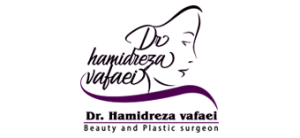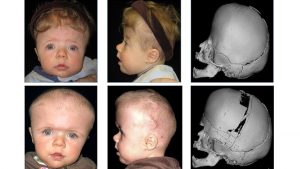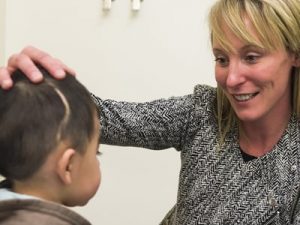Craniosynostosis
Craniosynostosis is usually diagnosed in very young infants, and doctors may recommend surgery. It’s natural to feel anxiety about surgery for a small baby, however, surgery for craniosynostosis is highly successful. A newborn’s skull consists of several plates of soft bone that are mobile, allowing passage through the birth canal when babies are born. These bones will eventually fuse together as he or she grows. In pediatric craniosynostosis, an infant’s skull bones fuse too early, which can restrict brain growth and result in abnormal head shape. This abnormal shape is often how parents are first alerted to something amiss.
Is my baby’s head a normal shape?
Babies’ heads come in all shapes and sizes. It’s normal for their head to be a slightly unusual shape. It will often get better as they grow.
But your baby may have a problem like a craniosynostosis if:
- their head is long and narrow – like a rugby ball
- their forehead is pointy or triangular
- 1 side of their head is flattened or bulging out
- the soft spot on the top of their head (fontanelle) disappears before they’re 1 year old
- their head seems small compared with their body
If the problem is very mild, it may not be noticeable until your child is older.
Diagnosis
Craniosynostosis requires evaluation by specialists, such as a pediatric neurosurgeon or plastic surgeon. Diagnosis of craniosynostosis may include:
- Physical exam.
Your doctor will feel your baby’s head for abnormalities such as suture ridges, and look for facial deformities.
- Imaging studies.
A computerized tomography (CT) scan of your baby’s skull can show whether any sutures have fused. Fused sutures are identifiable by their absence, because they’re invisible once fused, or by the ridging of the suture line. A laser scan and photographs also may be used to make precise measurements of the skull shape.
- Genetic testing.
If your doctor suspects an underlying genetic syndrome, genetic testing may help identify the syndrome.
Treatment of craniosynostosis
Mild cases of craniosynostosis may not need treatment. Your doctor may recommend a specially molded helmet to help reshape your baby’s head if the cranial sutures are open and the head shape is abnormal. In this case, the molded helmet can assist your baby’s brain growth and correct the shape of the skull. However, for some babies, surgery is the primary treatment. The type and timing of surgery depend on the type of craniosynostosis and whether there’s an underlying genetic syndrome. The point of surgery is to correct the abnormal head shape, reduce or prevent pressure on the brain, create room for the brain to grow in the normal way and improve your baby’s appearance. This involves the process of planning and surgery.
- Surgical planning
Imaging studies would help surgeons develop a surgical procedure plan. Virtual surgical planning for treatment of craniosynostosis uses high-definition 3-D CT scans of your baby’s skull to construct a computer-simulated, individualized surgical plan. According to that virtual surgical plan, customized templates are constructed to guide the procedure.
- Surgery
A team that includes a specialist in surgery of the head and face (craniofacial surgeon) and a specialist in brain surgery (neurosurgeon) generally performs the procedure. Surgery can be done by endoscopic or open surgery. Both types of procedures generally produce very good cosmetic results with a low risk of complications.
- Endoscopic surgery.
This minimally invasive surgery may be considered for babies up to age 6 months who have single-suture craniosynostosis. Using a lighted tube and camera (endoscope) inserted through small scalp incisions, the surgeon opens the affected suture to enable your baby’s brain to grow normally. Compared with an open procedure, endoscopic surgery has a smaller incision, typically involves only a one-night hospital stay and usually does not require a blood transfusion.
- Open surgery.
Generally, for babies who are older than 6 months, open surgery would be done. The surgeon will make an incision in the scalp and cranial bones then reshape the affected portion of the skull. The skull position is held in place with plates and screws that are absorbable. Open surgery typically involves a three- or four-day hospital stay, and blood transfusion is usually necessary. It’s generally a one-time procedure, but in complex cases, multiple open surgeries are often required to correct the baby’s head shape.
Long-lasting effects of craniosynostosis
Lots of children don’t have any lasting health problems. They may have a scar across the top of their heads if they had surgery, but this will be hidden by their hair and passing the time. Your child will have regular check-ups to see how they’re doing. These may be every few weeks at first but will become less frequent as they get older. If your child has severe craniosynostosis, surgery can’t always fully correct the shape of their head and they may need ongoing care.
craniosynostosis aftercare
Your baby’s surgeon may prescribe a special helmet to be worn, starting 3 weeks after the surgery. This helmet has to be worn to help further correct the shape of your baby’s head.
- The helmet needs to be worn every day for the first year after surgery.
- It has to be worn at least 23 hours a day. It can be removed during bathing.
- Even if your child is sleeping or playing, the helmet needs to be worn.
Your child should not go to school or daycare for at least 2 to 3 weeks after the surgery.
You’ll be taught how to measure your child’s head size. You should do this each week as instructed.
Your child will be able to return to normal activities and diet. Make sure your child doesn’t bump or hurt the head in any way. If your child is crawling, you may want to keep coffee tables and furniture with sharp edges out of the way until your child recovers.
If your child is younger than 1, ask the surgeon if you should raise your child’s head on a pillow during sleeping to prevent swelling around the face. Try to get your child to sleep on the back.
Swelling from the surgery should go away in about 3 weeks.
To help control your child’s pain, use children’s acetaminophen (Tylenol) as your child’s doctor advises.








Leave a Reply
Want to join the discussion?Feel free to contribute!